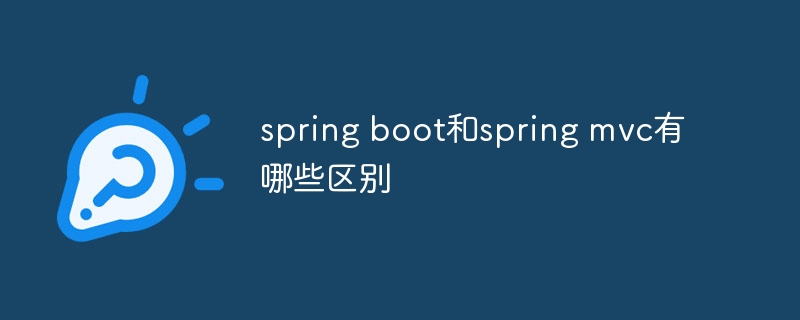
The differences between spring boot and spring mvc include different meanings, different configurations, different dependencies, different development times, different productivity, different ways to implement AR packaging functions, whether to provide batch processing functions, different functions, community and Documentation support differs, whether deployment descriptors are required, etc. Detailed introduction: 1. Different meanings. SpringBoot is a framework that simplifies Spring application development. It provides a series of automatic configuration, third-party library integration and out-of-the-box functions, allowing developers to get started quickly, etc.

The operating system for this tutorial: Windows 10 system, DELL G3 computer.
SpringBoot and SpringMVC are two sub-projects under the Spring framework. They have some differences in functions and application scenarios:
1. Different meanings:
SpringBoot is a framework that simplifies Spring application development. It provides a series of automatic configuration, third-party library integration and out-of-the-box functions, allowing developers to quickly get started and build their own applications. It mainly focuses on getting Spring applications up and running.
SpringMVC is a Servlet-based MVC (Model-View-Controller) framework. It mainly solves the problems of Web development and provides a set of logic and view rendering mechanisms for processing HTTP requests. It mainly focuses on request processing and response of the Web layer.
2. Different configurations:
The configuration of SpringBoot is relatively simple. It adopts the principle of convention over configuration, sets common configuration items by default, and Several configuration properties are provided to override the default values. Developers only need to focus on those properties that require personalized configuration.
The configuration of SpringMVC is relatively complex. It requires developers to define a series of configuration files (such as springmvc.xml) or use Java code for configuration. These configuration files contain information such as controllers that handle requests, view resolvers, static resource mappings, etc.
3. Different dependencies:
SpringBoot As a one-stop solution, it includes Spring framework, SpringMVC, MyBatis and many other modules. Developers only need Add the corresponding dependencies to use the functions provided by these modules.
SpringMVC As a Web framework, it depends on the Spring framework, but it also requires other modules (such as SpringBoot, MyBatis, etc.) to support data persistence, template engines, etc.
4. Different development times:
SpringBoot has a low entry threshold, and developers can quickly get started and develop. It provides a series of templates and code generation tools to reduce repetitive coding work.
SpringMVC requires developers to have certain web development experience in order to better utilize its functions. At the same time, the configuration of SpringMVC is relatively complex and requires more time to learn and practice.
5. Different productivity:
SpringBoot simplifies the development process of Spring applications and improves developer productivity. It provides a series of tools and functions, such as automatic configuration, code generation, health checking, etc., to help developers quickly build highly available applications.
SpringMVC mainly focuses on the request processing of the Web layer, and its function is relatively single. Although SpringMVC can implement some advanced functions through configuration and extension, there is a certain gap compared to SpringBoot in terms of productivity.
6. There are different ways to implement JAR packaging function:
SpringBoot adopts a principle called "convention over configuration" to separate common configuration items. Default settings are provided, and some configuration properties are provided to override the default values. Developers only need to focus on those properties that require personalized configuration.
The configuration of SpringMVC is relatively complex. It requires developers to define a series of configuration files (such as springmvc.xml) or use Java code for configuration. These configuration files contain information such as controllers that handle requests, view resolvers, static resource mappings, etc.
7. Whether to provide batch processing function:
SpringBoot provides batch processing function. Developers can define multiple @Bean methods in one file, and SpringBoot will automatically Identify and create the corresponding Bean.
SpringMVC does not provide similar batch processing functions, and developers need to manually define and configure Beans.
8. Different functions:
SpringBoot is mainly used to build independent Spring applications, which can handle the startup, configuration and management of applications.
SpringMVC is mainly used to process Web layer requests. It provides a set of logic and view rendering mechanisms for processing HTTP requests.
9. Community and documentation support are different:
SpringBoot, as an important branch of the Spring framework, has a huge community and rich documentation resources. Developers can easily find relevant materials and examples to learn and practice.
SpringMVC’s community is relatively small, but it still has a certain degree of influence and attention. Developers can find relevant information and examples from Spring official documentation and some technical blogs.
10. Whether a deployment descriptor is required:
SpringBoot does not require a deployment descriptor. It identifies the entry point of an application through the @SpringBootApplication annotation.
SpringMVC requires a deployment descriptor (such as springmvc.xml), which contains information such as controllers, view resolvers, static resource mappings, etc. that handle requests.
Summary: SpringBoot and SpringMVC have certain differences in functions, configuration, dependencies, development time, productivity, etc. In practical applications, developers can choose the appropriate framework based on their needs and skill levels. For beginners and scenarios that require rapid application development, SpringBoot is a better choice; and for Web development scenarios that require more flexibility and customization, SpringMVC may be a better choice.
The above is the detailed content of What are the differences between spring boot and spring mvc. For more information, please follow other related articles on the PHP Chinese website!




